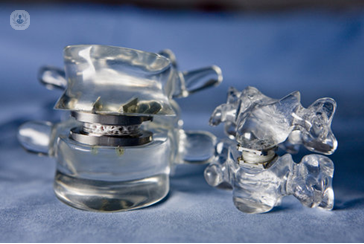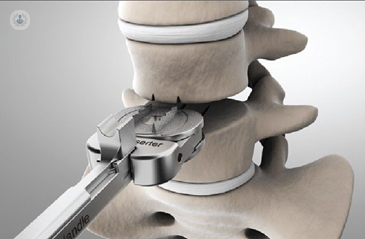
All you need to know about artificial disc implants
Artificial discs are devices that are implanted after a complete resection of a vertebral disc to enable the normal biomechanical mobility of the cervical and lumbar spine.
Disc prostheses, or artificial discs, are used in all cases of disc disease, degenerative discopathy, and disc herniation, with or without nerve root compressive symptomatology that does not improve after a period of 4-6 weeks of intensive rehabilitative treatment.

The benefits of artificial discs for cervical and lumbar spine
- Maintain mobility
- Maintain stability
- Restore cervical and lumbar normal lordosis
- Reduce disc degeneration of adjacent segments
- Eliminate the need for bone grafting
- Early initiation of postsurgical mobility
- Early return to normal life
The artificial disc implant procedure
- Minimally invasive anterior cervical or lumbar approach (ALIF). In the case of a lumbar disc superior to L4, the lateral approach (XLIF).
- Complete resection of the pathological disk until full release of the spinal canal and nerve roots.
- Preparation of the disc space receiving the prosthesis dials
- Selection of the correct size and angulation of the prosthesis to be implanted
- Placement of the prosthesis and radiological verification of its accurate placement
- Close with an intradermal suture to make the scar invisible.
The surgical procedure is considered low risk due to the minimal complications that may occur, which are:
- Bleeding (rare)
- Infections (rare)
- Damage to nerve structures (infrequent)
- Dural tear (infrequent)
- Injury to large vessels, oesophagus, trachea, or intra-abdominal organs (exceptional)
Postoperative care
 After cervical surgery, hospital admission for 24-48 hours is required. There is minimal discomfort in the surgical wound area. Absolute rest is not necessary. The patient is advised to wear a soft collar for the first week for activities outside the home. They can return to work between 2 and 3 weeks after surgery, depending on the type of work activity.
After cervical surgery, hospital admission for 24-48 hours is required. There is minimal discomfort in the surgical wound area. Absolute rest is not necessary. The patient is advised to wear a soft collar for the first week for activities outside the home. They can return to work between 2 and 3 weeks after surgery, depending on the type of work activity.
After lumbar surgery, hospital admission is for approximately 3-5 days. There is also minimal discomfort in the area of the surgical wound. Rest is not necessary and the patient can return to their normal routine after 3-4 weeks.

